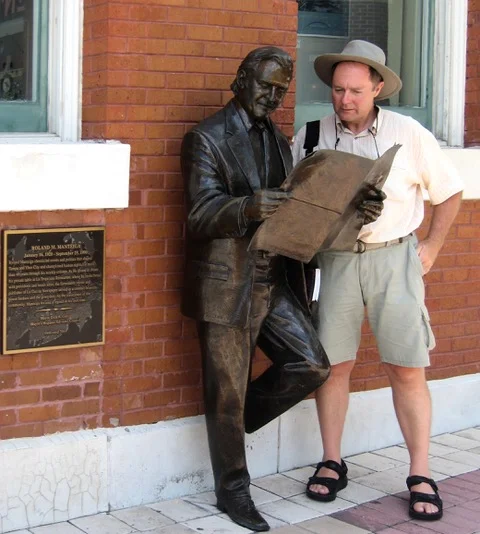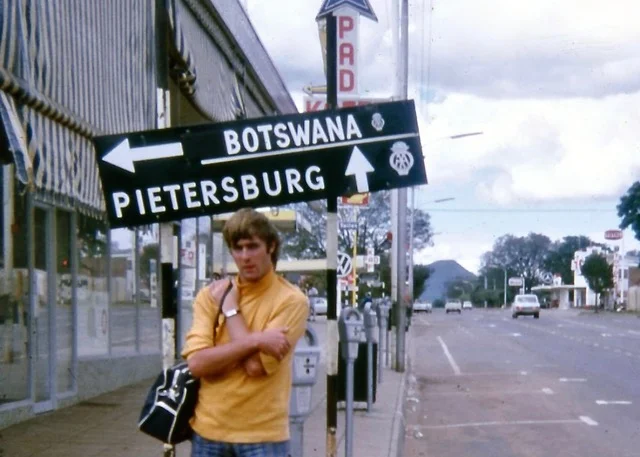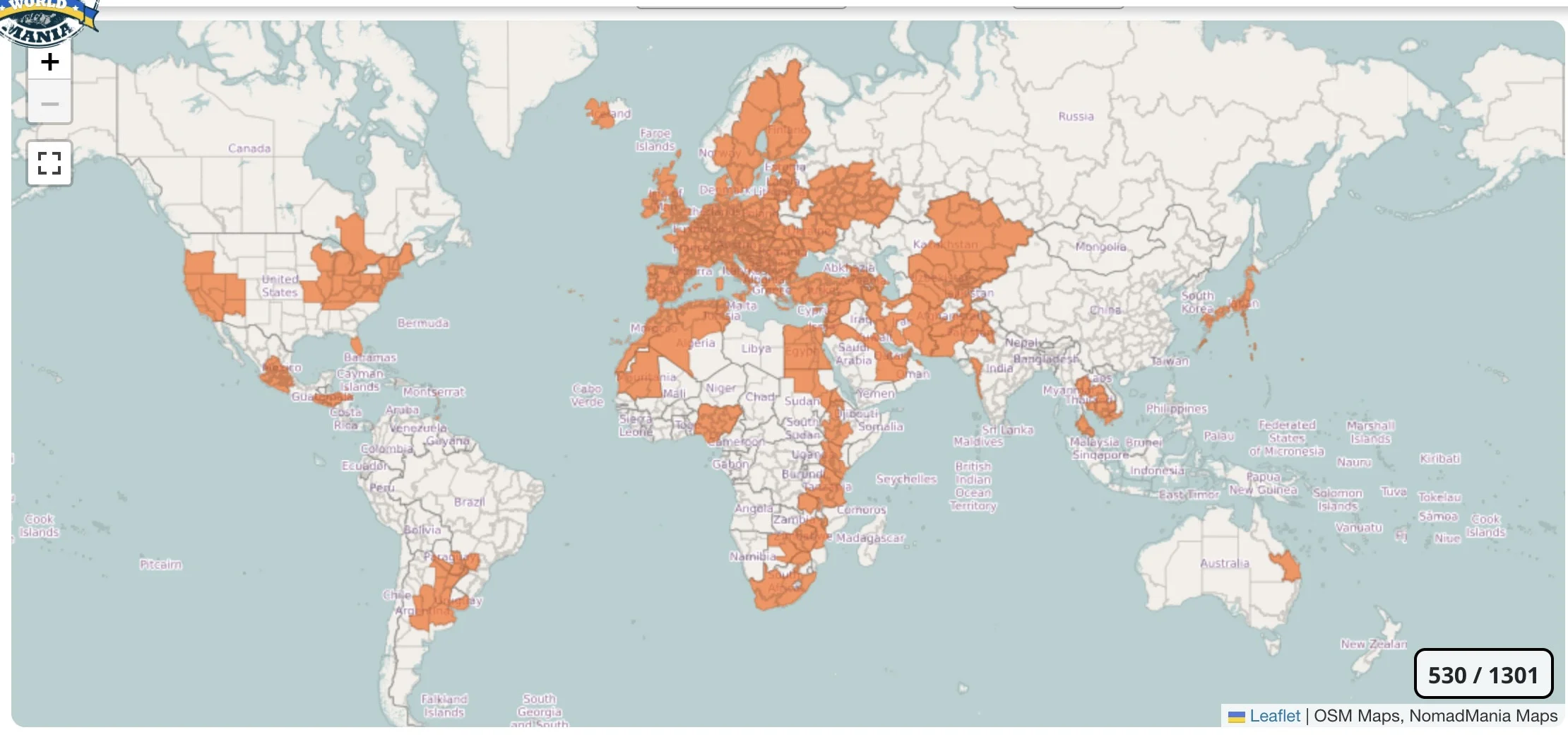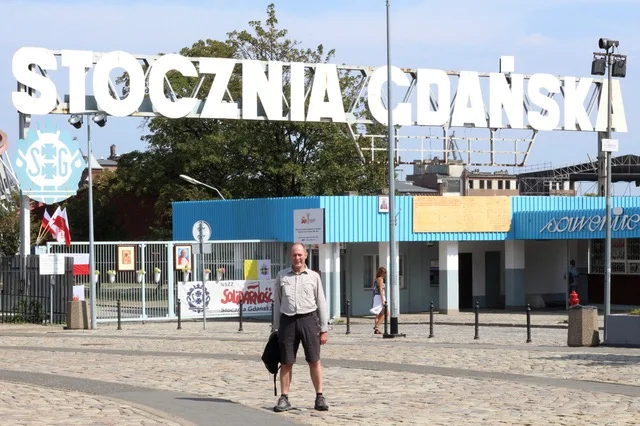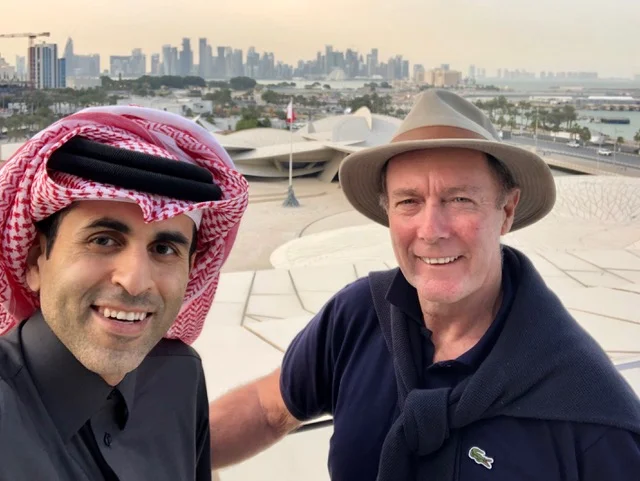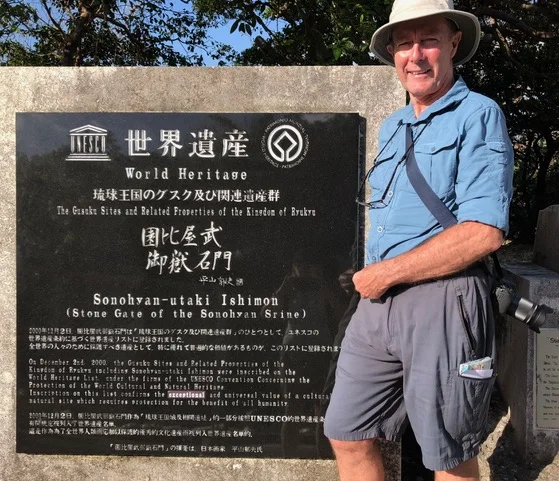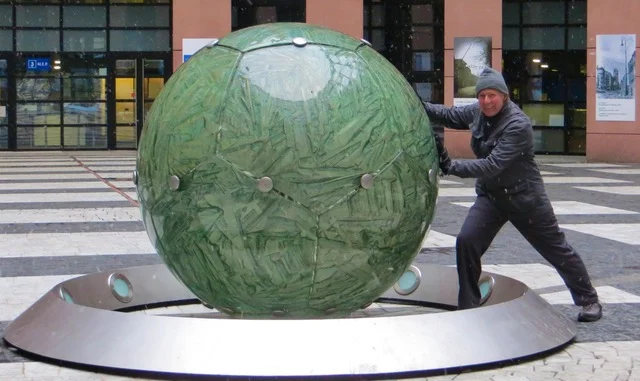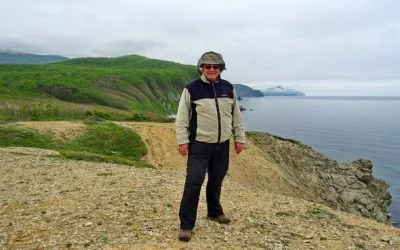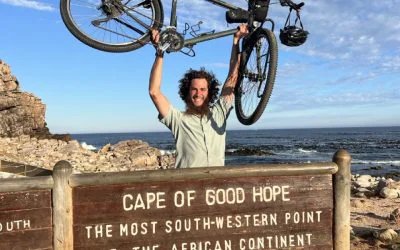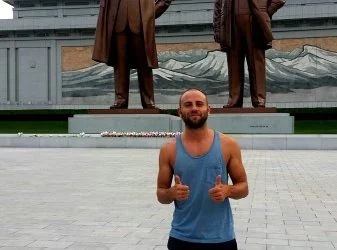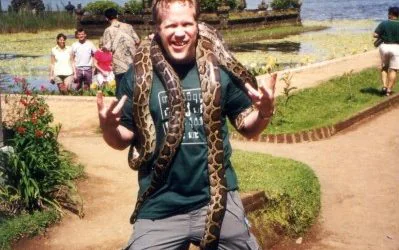Welcome to our exclusive interview featuring the intrepid Frank Britton, a seasoned wanderer whose footsteps have sketched maps of memories across the globe. Guest interviewer and fellow NomadManian, Janie Borisov, sits down with Frank to navigate the chronicles of his lifelong voyage.
Through his eyes, we’ll uncover the essence of nomadic passion, the allure of UNESCO sites, and the art of connecting with cultures through their culinary delights and historic marvels. This is more than just an interview; it’s a gateway into the soul of a true nomad.
Manteiga newspaper man. Ybor City, 2008
When did you first discover your passion for traveling?
That’s a question I’ve often pondered over the years. I think my early affection for geography probably had something to do with it. Geography was my favorite subject in school, and I always enjoyed reading atlases. While others might settle down to read a novel or a newspaper, I would open an atlas and mull over it. At that stage, I hadn’t left Ireland and knew very little about the world, but there was something fascinating and intriguing about all the lines, colors, and names, etc. So, that was a very early thing that has continued and still carries on—that fascination with the atlas. And now we have Google Maps, which brings it alive in another kind of way.
Another thing was that, even though I lived in the Northwest, in Donegal, Ireland, I had this dream—even at the age of eight, nine, ten, or eleven—to see other countries, to visit new places. It wasn’t born out of anything in particular, but the desire was always there. And it was something that, later, as I got into my late teens and early twenties, began to propel me forward, and it has stayed with me ever since.
On The Road. Cape to Cairo, Mokopane/Potgietersrus,1973.
Do you think this passion for travel runs in the family? Were your parents travellers, or are you the first?
No, I’m the first. My parents weren’t travellers, but I can trace the trait back to earlier generations, which may have had some impact. For instance, there was a distant cousin, about six generations back, who left Ireland in 1843 and went to the Quebec province in Canada. There, she became involved in nursing and medicine and played a significant role in distributing live smallpox vaccines to new settlements in that province. She is commemorated in Quebec for her work during that time.
Another relative who might have influenced me was my father’s Uncle Tom. In 1912, he sailed for Australia. While this in itself wasn’t unusual, the journey took 38 days, and he documented each day meticulously in a diary, which I have a copy of. It details every port they called into; it wasn’t a direct sea route—they stopped in places like Marseille and Port Said before going through the canals. His diary entries are fascinating because they capture his wonder at sights he’d never imagined. Remember, in 1912, there was no television and few books that depicted what the world was like elsewhere. He eventually settled in Melbourne. So, while I am the first immediate traveler in my family, there are certainly traces of this trait in my ancestry, which is quite fascinating.
That must have been a fascinating read for you, knowing that it’s about your actual uncle. Do you still love maps?
I absolutely love maps, atlases, and globes. I have a large wall map in another room, just like yours. I’m also fascinated with old atlases and the early ones from maybe a hundred years ago, showing the various countries, the shapes that have changed, the empires that have come and gone, if you know what I mean. I haven’t changed much necessarily, but the world has continued to evolve, and it’s nice to look back and see how things were and compare them with how they are now.
Frank’s NomadMania map
Did you do some traveling as a young man?
My first time leaving Ireland was at age 18. Our family didn’t travel much, just holidays around Donegal. We didn’t go very far. At 18, I left home for London after finishing my exams. It was 1970, and London was in full swing. But the real journey began at 19, when I arrived in Johannesburg, South Africa. That was the start of a lifelong journey, though it was intermittent due to family and work commitments.
It started in 1971 and continued until ’75, then it was on and off until 2009, which is when my travels truly took off. This is it now; I’m in the thick of it, you might say, enjoying my second adolescence, really.
Would you like to tell us a bit more about those first trips? They must have been epic.
Traveling back then wasn’t as easy as it is now. You couldn’t just get online and book a flight. There was a lot of overlanding. The idea of flying wasn’t on the agenda. People didn’t fly in the way we do now. Instead of taking a seven-hour train journey, we now take a flight. Back then, you took the ten-hour train journey. You waited at border crossings for days. I once waited three days at a border for the next vehicle.
Where was that?
That was on the border between what is now Eritrea, which was then part of Ethiopia, and Sudan. I was waiting for a lift to Kasala.
Where late 20thC European history started. Lenin Shipyard, Gdansk, 2015
So you started right in the deep end?
It was rather hardcore. This trip was to Cairo, and it took about six months, I think. It was fascinating because there was no internet, no guidebooks, you couldn’t book a hotel or accommodation in advance. So, I was heading north, and yes, I had a map. I knew where north was and was following what I thought was the straightest line. The information about what was ahead came from people who were traveling in the opposite direction. You’d meet them on the street—there weren’t many people who looked like you in Mozambique or Malawi, so it was relatively easy to start a conversation. They would tell you about the buses, trains, or other means of transportation, and about places to stay.
In some cities, like Mombasa, there were places known to travelers, usually houses owned by individuals who welcomed people passing through. These places were also where you met others, a hub of sorts, with a constant ebb and flow of people coming in from different parts of Africa—Tanzania, Zambia, or maybe from the west, having crossed through Congo. We shared a few days together, exchanging stories, making friends, and gathering new information before setting off again.
There were a few key routes in Africa at that time. One was along the eastern side, from Cape to Cairo. Another was coming down from Morocco through West Africa, which is still a route today. And then there was the route through Algeria, crossing the center of the Sahara, which also had a romantic allure. People talked about having come through Timbuktu, for example.
Some travelers went off the radar, venturing deep into places like the Congo, traveling much like the first explorers did a hundred years before. I wasn’t one of them, but you met some really interesting people with different stories to tell from those experiences.
Meet up Nasser Almohamadi. National Museum, Doha, 2020
What sort of things do you seek out? What do you find the most interesting in your travels?
I’m interested in architecture, people, food, and everything in between. I’m not particularly a foodie, but I do make it a point to try local dishes. My main interest lies in UNESCO sites, though I tend to travel from city to city using whatever transport links are available, which means I often visit the main towns or cities. If there’s a site nearby, I’ll make the effort to see it. I have a fondness for museums, particularly art museums. I enjoy seeing the modern and sometimes contemporary art of a country. Cities and towns often have galleries showcasing the art history of the nation, which I find quite fascinating.
I take a lot of photographs – of historical and modern buildings, street scenes, people walking, talking, and going about their business. There are always two things I carry with me when I travel: a book, which is sometimes by a novelist from the country I’m visiting if they’ve achieved some renown, and a camera. I used to carry a digital camera, but now I just use my phone. The clarity or depth of field might not always be as good, but I feel I can capture something special about a location. Out of a hundred images taken in a day, there may only be two or three that hold real meaning, often with a person in them, doing something or nothing.
It’s much easier with a phone camera. You can capture a scene discreetly; you blend in because everyone is using their phones to take photos. I enjoy capturing people as they photograph their surroundings. The fact that you can edit your photos and post them on Facebook within an hour of taking them is just unbelievable. Plus, the phone is like a computer – you can manage emails, book flights, hotels, it’s your whole world. I can hardly imagine traveling without it now.
Are you not nostalgic for the times when you found out everything by just talking to people?
Not really, no. It sounds cool, and back in its day, it was the way everyone did it. But now, with NomadMania, it’s been a revolution for travel. Before NomadMania, I’d pick a spot on the map and just go. Now, it’s much more focused. You’re not only identifying a place to go, but you’re also looking at the areas around it. One of the joys of traveling with NomadMania is colouring in those regions. It’s definitely changed the way we travel. Before NomadMania, there were other travel sites, but NomadMania really appealed to me. I joined around 2016-17 and have never looked back. I appreciate the sense of community it fosters, including meetings and events, like the one I organized in Dublin earlier this year.
I like UNESCO’s. Inscription reads ‘Stone Gate of the Sonohyan Srine’. Outside sacred forest, Shurijo Castle. Naha, 2018
Regarding my recent travels, I won’t answer your question directly but tell you something else. Twice in my life, I have been moved to tears by what I’ve seen or experienced. The first time was in Tsavo National Park in Kenya, during the early ’70s. There was a scene at sunset, with animals walking towards the horizon and a plume of dust rising behind them. It was so primal and moving that I was brought to tears. The second time was last year, when I heard a Bedouin song around a campfire that I learned back in 1974 in Petra, Jordan. Hearing it again after so many years was incredibly moving.
Briefly, regarding my recent travels, Mauritania was wonderful, with incredibly generous people and beautiful deserts and oases. In Central America, I found El Salvador particularly interesting. The people expressed happiness with the changes the president had made, giving them their lives back from the threat of gangs. I’ve also enjoyed California’s West Coast and just recently returned from Central Asia, where for the first time, I joined a tour group after travelling solo to over 100 countries.
I’ll have to ask our infamous NomadMania question – if you could invite three or four personalities to dinner, who would they be and why?
I would like to invite my wife Paula without whose support my ability to travel would be much restricted. She keeps the home and family base together, thus giving me the freedom to venture forth.
I would also invite my cousin from the 1840s, I’d be fascinated to hear about her experiences and what life was like back then. Despite the toughness of those times, she must have been a remarkable woman to have made such a valuable contribution to healthcare in what would have been a very primitive place.
I’d choose my Uncle Tom who went to Australia in 1912. I’d look forward to hearing about his experiences and sharing with him that the adventurous gene lives on. Another invitee would be Jack Kerouac, whose book ‘On the Road’ really resonated with me. It’s in my forever library and I still recommend it as a must-read to many people. It speaks to you in a very powerful way.
Also, I would mention Jorge Sanchez from the Barcelona area, who, I believe, was on Nomad Mania until a couple of years ago. His diaries and writings are very insightful, as he travelled extensively, very much at ground level, almost like an itinerant traveller. It wasn’t about money for him – he didn’t have much – but about the experiences and the prolonged engagement with the countries he visited. He was a bit of an influence on me.
Finally, I would include Harry Mitsidis for what he has done with Nomad Mania, for turning it into a travel site that makes an incredible contribution to those who love to travel. I’m sure I’ll meet him at some point, but he would definitely be at my dinner table. So, those are the few people I’d choose.
‘United Earth’, EU Parliament, Strasbourg, 2012
Our conversation with Frank has been nothing short of a virtual expedition across continents, through time, and into the human spirit. His stories remind us that travel isn’t just about places we visit, but the moments that take our breath away and the people whose stories touch our hearts.
We extend our deepest gratitude to Frank for sharing his inspiring journey with us, and to Janie Boriskov for adeptly steering this captivating narrative. Their exchange celebrates not only the wanderlust that propels us but also the shared humanity that unites the NomadMania community.
